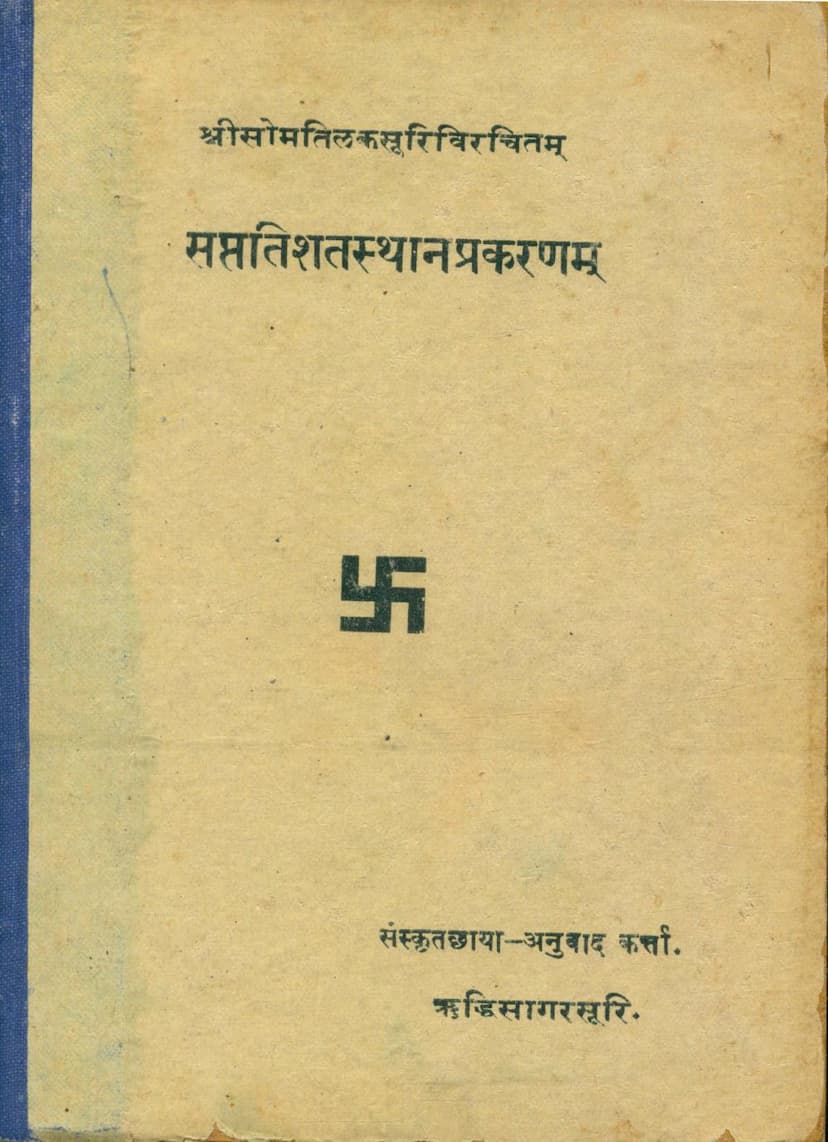Saptatishatsthanprakaranam
Added to library: September 2, 2025

Summary
This is a comprehensive summary of the Jain text "Saptatishatsthanprakaranam" by Somtilaksuri, translated and commented upon by Riddhisagarsuri, and published by Shrimad Buddhisagar Suri Jain Gyanmandir, Vijapur.
The book, "Saptatishatsthanprakaranam" (सप्ततिशतस्थानप्रकरणम्), literally meaning "Treatise on Seventy-Hundred Places" or "Treatise on 170 Places," is a Jain scripture that details the previous lives and significant events in the lives of the 24 Tirthankaras. The catalog link provided indicates it's a Sanskrit text with a translation/commentary.
Here's a breakdown of the key aspects of the book based on the provided text:
1. Title and Authorship:
- Original Author: Shrimad Somtilaksuri (श्रीसोमतिलकसूरि)
- Translator/Commentator: Shrimad Riddhisagarsuri (श्री-ऋद्धिसागरसूरि)
- Publisher: Shrimad Buddhisagar Suri Jain Gyanmandir, Vijapur.
- Sanskrit Title: Saptatishatsthanprakaranam (सप्ततिशतस्थानप्रकरणम्)
2. Core Subject Matter: The primary focus of the "Saptatishatsthanprakaranam" is to systematically compile and present the "170 places" (एक से सीतेर स्थान) related to the lives of the 24 Tirthankaras. These "places" refer to the significant events and circumstances of their previous births and their lives as Tirthankaras, including:
- The 170 previous birth-related places (पूर्वभव-इठाण सत्तरिसयं): This is the core of the text, detailing the past lives, birthplaces, lineages, teachers, lifespan, and other crucial details of each Tirthankara's journey to enlightenment.
- The Five Kalyanaks (पञ्चकल्याणक): The text likely covers the five auspicious events in a Tirthankara's life: Chyavan (descent into the womb), Janm (birth), Diksha (renunciation), Kevalgyan (omniscience), and Nirvana (liberation).
- Specific Details covered for each Tirthankara:
- Birthplaces (जन्मदेश, जन्मस्थान): Countries, cities, and specific locations.
- Parents: Names of mothers and fathers.
- Lifespan (आयुष्य): Duration of their lives.
- Physical Attributes: Body marks (लांञ्छन), height (उत्सेध), color (वर्ण), strength (बल).
- Family and lineage: Dynasty (वंश).
- Dreams of the Mother (स्वप्न): The auspicious dreams a mother sees before the birth of a Tirthankara.
- Diet: Types of food consumed during different stages of life, including their first alms (प्रथम पारण).
- Ascetic Practices: Details about their renunciation, penance (तप), and ascetic lifestyle.
- Number of Disciples: The count of monks (साधु) and nuns (साध्वी).
- Kevalgyan: The location, time, constellation, and other details surrounding their attainment of omniscience.
- Nirvana: The place and time of their liberation.
- Shasan Devatas: Guardian deities associated with each Tirthankara.
- Chakravartis, Baladevas, Vasudevas, Prativāsudevas, and Rudras: Significant figures in their reigns and lives.
- Philosophical Views: The text seems to touch upon the rise of different philosophical schools (दर्शने).
- Miraculous Events (आश्चर्य): Extraordinary occurrences related to their lives.
- Milestones: The number of years spent in different stages of life (e.g., as a prince, king, ascetic).
- Miraculous Incidents: Mention of miracles like the Meau Mountain shaking due to Mahavir's toe.
- Specific details about deities and their roles: The involvement of Indra and other deities in Tirthankara's lives.
- The Epochs (आरा): The text describes the characteristics and duration of the six Aryas (epochs) of the Jambu Dvipa and their impact on the lifespan and characteristics of Tirthankaras.
3. Structure and Content: The text is organized into 170 "places" (स्थान), each detailing a specific piece of information about the Tirthankaras. The summary indicates that the book delves into a vast array of details, covering the entirety of the Tirthankaras' existence across multiple lifetimes.
4. Commentary and Translation: The commentary by Riddhisagarsuri is crucial for making the original Sanskrit text accessible. The preface and introductory remarks highlight the importance of compiling this information, as it was scattered across various Agamas and Prakaranas, making it difficult for scholars to grasp the complete picture. Riddhisagarsuri's contribution includes a Sanskrit "chhaya" (shadow text, essentially a more literal Sanskrit rendering or paraphrase) and a Gujarati translation (भावार्थ) for clarity.
5. Biographical Information: The text includes biographical details about the original author, Somtilaksuri, noting his birth in Samvat 1355, receiving initiation in 1369, and achieving spiritual leadership in 1373, with his demise in 1424 at the age of 69. It also mentions his gurus and disciples.
6. Historical and Comparative Aspects: The preface discusses the compilation of this work based on a request from Hemchandra, son of Ratanchand, highlighting the collaborative effort and the desire to present comprehensive information. The text also mentions discrepancies or differing opinions found in other texts (e.g., concerning the constellation of Mahavir's Chyavan), indicating a scholarly approach to reconciling information.
7. Publisher and Context: The publication by Shrimad Buddhisagar Suri Jain Gyanmandir in Vijapur, Gujarat, and the mention of the year V.S. 1990 (V.E. 2460), suggests a project aimed at preserving and disseminating Jain knowledge in the Gujarati-speaking region. The support from various Jain sanghs and individuals for printing the book further emphasizes its religious and educational significance.
In essence, "Saptatishatsthanprakaranam" is a monumental work of Jain scripture that provides an encyclopedic account of the lives of the Tirthankaras, drawing from the vast Jain Agamic literature. It serves as a valuable resource for understanding the biographical details, past lives, and auspicious events associated with these revered spiritual guides.